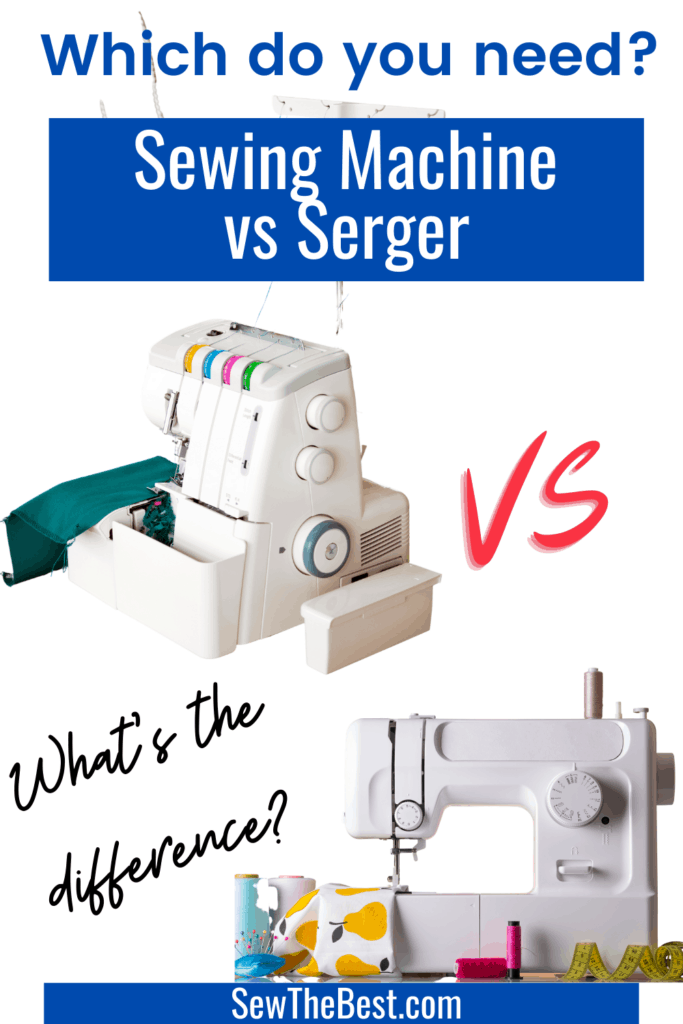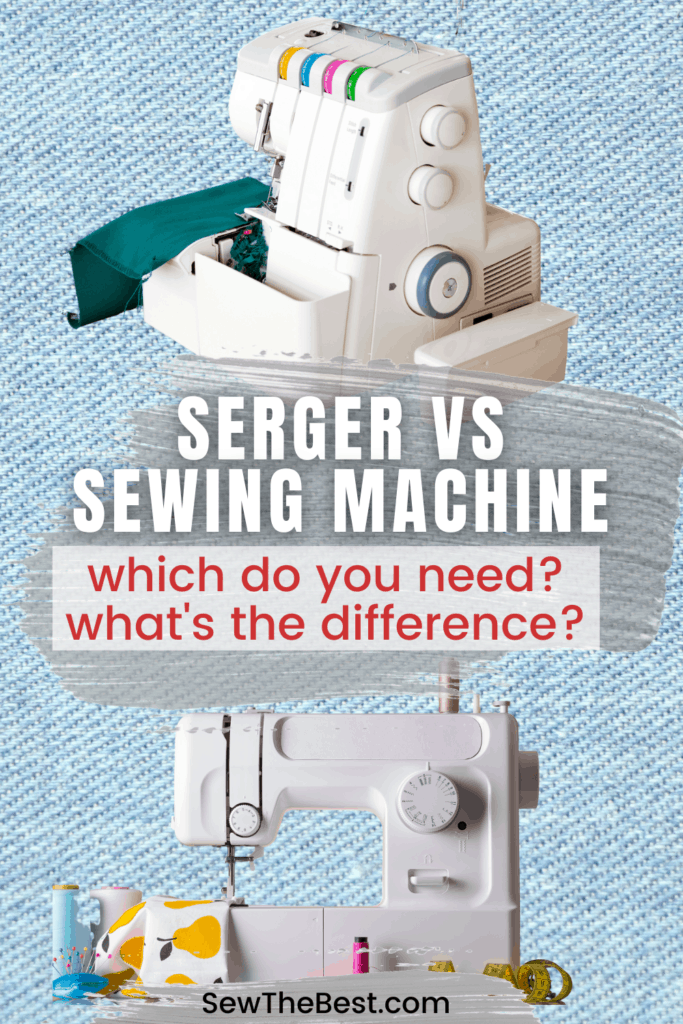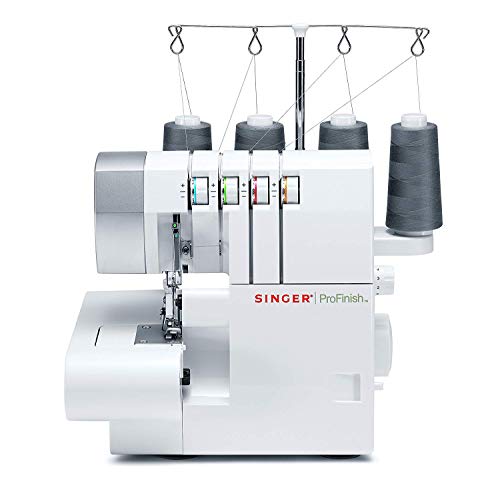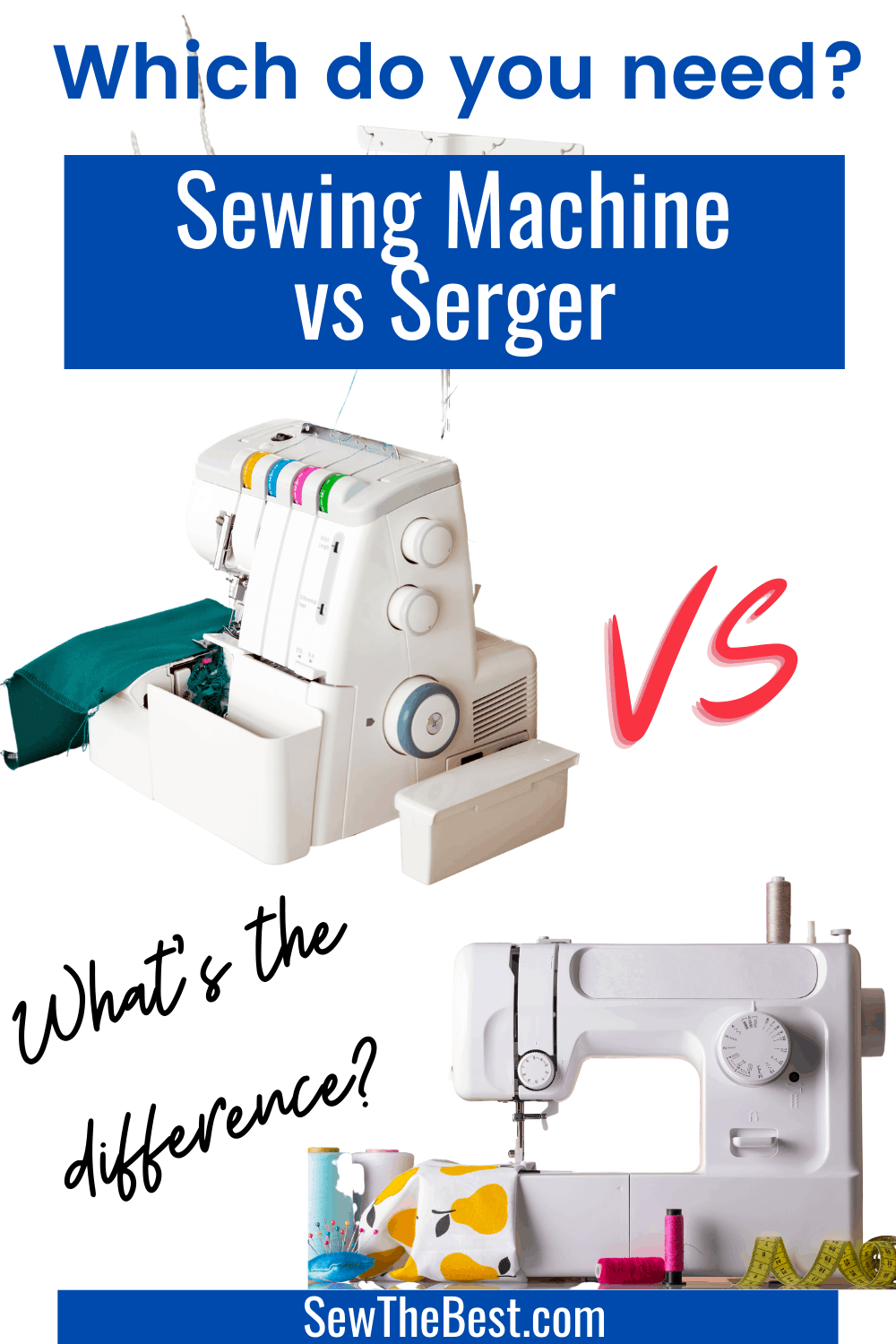Sewing machine vs Serger – do you know difference between a sewing machine and a serger? Do you know what a serger machine is and what serging is? In this post, you will learn to tell the difference between a serger and a sewing machine. You will know which is better a sewing machine or a serger. You will be able to decide if you need a serger or a sewing machine. Keep reading to learn all about sergers and sewing machines.

What does a serger do?
So, what is a serger? A serger is a type of machine that specializes in finishing the edges of fabric. Finishing the edges with a serger is called serging. Serging protects the edges of your fabric so that they do not come unraveled. If the edges of your fabric are left unfinished, general wear and tear would slowly unravel most fabrics to the seam. This seam would become unstable and eventually come apart. This would ruin your hard work sewing. For this reason, finishing the edges of the fabric on your projects is very important.
Serger sewing machines serge the fabric edges in a loop, either overcasting or cover stitching and sergers that have an additional zigzag stitch can serge with an elastic stitch. Serger sewing machine stitches are strong enough to sew medium weight woven fabrics, knitwear and synthetic fabrics such as Lycra. Serged seams are used on garments whose fabric is either too delicate or too thick for sewing in one step using a sewing machine. Serging is the preferred joining method for garments featuring fine fabrics such as crochet, silk, wool or lace. These serging sewing machines are also used when serging knits, sewing stretch fabrics and sewing light to medium weight woven fabric. Some serger sewing machines can sew normal fabrics but have limited capabilities of sewing heavy fabrics.
Sergers are often called overlock machines. This is because sergers can do a type of stitch called the overlock stitch. This is different from a coverstitch machine, which can sew a cover stitch. Some sergers can sew both coverstitch and overlock stitch, but those machines are more rare and often more pricey! Coverstitch is a great stitch for stretchy fabrics and knit fabric. An overlock stitch will stretch and move with the fabric, unlike an overlock stitch.
Sergers work by encasing the edges of your fabric in multiple strands of thread. Sergers can have anywhere from two to five or more different spools of threads that they are using simultaneously. As the serger encases the edge of your fabric, it will also be slightly trimming the edge. This trimming allows the edge to be fully encased in the thread and gives a more professional appearance to your work.
Sergers can use many different types of stitches. These stitches differ in what type of fabric they are good for. If you are sewing stretchy fabric and you want to retain the stretch, you definitely want to use a serger to finish the fabric edges. Sergers also sew extremely fast. Some sergers can sew as many as 1700 stitches per minute!
Sergers are very dedicated to one task – finishing the edges of fabric. They are extremely good at this one task. While you can use a serger to sew pieces of fabric together, it is not nearly as effective as a sewing machine at this.
What does a sewing machine do?
Sewing machines are machines specialized in sewing fabric. This can be as simple as regular sewing where you join two pieces of fabric together, or much more complex computerized embroidery machines. A basic sewing machine is great for sewing two pieces of fabric together. It can also be used to sew button holes, attach zippers, or encase edges of fabric with a zig-zag stitch. Depending on the presser foot you use, you can even quilt and do some limited free motion embroidery with a basic sewing machine. Basic sewing machines are much more versatile than a serger.
Basic sewing machines use two to three spools of thread at a time. The most common setup involves two spools of thread. There is one spool on top of the machine that runs through the sewing needle, then another spool under the machine in the bobbin. These two pieces of thread are wrapped together as you sew. When a double needle is used on a sewing machine, you would add another spool of thread on top of the machine to go through the second needle.
Sewing machine have attachments called presser feet that allow them to perform many functions. Some basic presser feet include the zigzag foot, for doing a zig zag stitch, a zipper foot for sewing in zippers, and a button hole foot for sewing button holes. There are literally a ton of different presser feet available for use with sewing machines.
A normal sewing machine can make many different stitches. With presser feet, they are even more versatile. Sewing machines can finish the edges of fabric (although not as well as a serger), sew pieces of fabric together, and decorate fabric.
What is the difference between a serger and a sewing machine?
A serger and a sewing machine both perform essential tasks in a garment manufacturing. A serger is a more specialized type of sewing equipment while a regular sewing machine has broad functionality that can support all garment fabrication processes from cutting to finishing, as well as quilting and embroidery. While the two machines do share many similarities, sergers and sewing machines have some unique tasks that make them fundamentally different.
A serger or also called serging sewing machine is a tailor’s tool that joins the fabric by using an overcasting, cover stitch, and a zigzag. These features prevent fraying and raveling of the cut edges while providing a sturdy seam with stretchable thread. On the other hand, sewing machines are used to sew pieces of fabric together using a straight stitch, zigzag or decorative stitches.
The big difference between sewing machine and serger can be summarized as this. Sergers are machines dedicated to finishing the cut edges of fabric. Sewing machines are more general machines that can sew fabric, finish cut edges, quilt, and embroider. While you can use a serger for sewing pieces of fabric together, you have to use special stitches for serger sewing and some sergers cannot sew fabric together. Serger machines use anywhere from three to eight spools of thread, sewing machines usually use one and max out at two spools of thread. Serger machines often cut the fabric to encase the raw edges as they sew, sewing machines don’t cut the fabric. Serger machines sew significantly faster than sewing machines, often double the stitches per minute of a sewing machine. Sewing machines can finish the edge of the fabric, but they won’t totally encase the seam allowance in thread the way a serger does.
Serger Vs. Sewing Machine Table
| Serger Machine | Sewing Machine |
|---|---|
| Dedicated to protecting and finishing the edges of cut fabric. | General machine that can sew fabric together, protect fabric edges, embroider, quilt, and more. |
| Uses anywhere from three to eight spools of thread, called cones. | Normally uses one spool of thread but can use up to two. |
| Can cut the fabric as it encases the edges. | Does not trim the fabric as it sews. |
| On average sews 1300 to 1500 stitches per minute. | On average sews 300 to 800 stitches per minute. |
Which is better, serger or sewing machine?

So which is better, serger vs sewing machine? Sergers and sewing machines are two different machines. Trying to choose which one is better is like trying to compare apples and oranges. Sewing machines are great jack of all trades machines. They can do sewing, they can do quilting, they can do embroidery, and they can do edge finishing with the right setup. Sergers, or overlock machines, are dedicated to finishing the edges of fabric. They give a very polished look when they are used, but they are not needed to be successful at sewing projects. Now, if you are comparing sewing machines to sergers strictly in regards to which finishes fabric edges better, then a serger will win that comparison hands down. Sergers are better than sewing machines at finishing the edges of fabric. Sewing machines have more utility than sergers.
Here’s a great video that shows the differences with a serger vs sewing machine.
Do I really need a serger?
No, you do not need a serger to sew many beautiful projects. Sergers are great tools to have, but they are not a need. Sewing machines can finish the edges of fabric with a zigzag stitch. There are also many different stitch types that you can do that protect the cut edges of fabric as you sew. French seams would be a great example of this. Serger and sewing machine can be used interchangeably in many cases. A serger is best suited for fabrics with a woven structure such as cotton twill or denim that require serging, while most other fabrics including knits can be sewn by a regular sewing machine.
That said, if you plan on sewing stretchy materials like cotton knits or spandex, you should get a serger. Sewing machines cannot finish the edges of stretchy materials in a way that allows the material to retain it’s stretch. Zigzag and overcast stitches are non-stretchy. So if you used one to protect the edges of your fabric, that edge would become non-stretchy. This would defeat the purpose of using a stretchy material if all of your edges didn’t stretch. You would end up with very distinct lines in your project when it was used, or the seams would pop.
Should I get a serger or a sewing machine?
So, should you get a serger or a sewing machine? It depends on what you are trying to do. Sergers are best suited for decorative finishing tasks such as hemming and serging fabric edges for trims and bindings. Regular sewing machines are best for basic seam construction such as joining pants legs or sewing a shirt sleeve to a shirt body.
You should get a sewing machine if…
If you are primarily looking to sew fabric together, you want to get a sewing machine. If you are interested in quilting then you should get a sewing machine. If you want to make your own clothes, and you do not already have a sewing machine, you should get a sewing machine.
In general, if you do not already have a sewing machine and you are debating between a sewing machine and an overlock machine, you should get a sewing machine.
You should get a serger if…
If you already have a sewing machine that works quite satisfactory, you should get a serger. Sewing machines are great for sewing. They can even finish the edges of fabric. The edges are not quite as polished as the edges finished by an overlock machine though. So if you already have a sewing machine and are debating if you should get a new sewing machine or a serger, you should get a serger.
Best Serger and Sewing Machines to Buy
If you’re in a hurry (or just curious!) –
✅ Check deals on Sergers and Sewing Machines
3 Great Sergers for You
Best Basic Serger

- Durable metal frame
- 3 and 4 thread serger
- 1300 stitches per minute
- LED light
- Color coded easy thread system
- 1mm to 4mm stitch width
- 1 / 5 / 25 year limited warranty
Best All Around Serger

- Durable metal frame
- 2, 3, and 4 thread serger
- 1300 stitches per minute
- LED light
- Color coded easy thread system
- 90 day / 2 year / 25 year limited warranty
Best Advanced Serger

- Durable metal frame
- 2, 3, 4, and 5 thread serger
- 1300 stitches per minute
- LED light
- Color coded easy thread system
- Can sew a cover stitch
- 90 day / 2 year / 25 year limited warranty
1. Best Basic Serger: Brother 1034DX Overlock Machine

This machine is perfect for someone who is looking to turn out professional quality sewing projects. You can use it to finish the edges and hems of your projects much faster than a traditional sewing machine with it’s stitch speed of 1300 stitches per minute. The Brother 1034DX is also perfect for creating decorative edges like gathering and ruffling, or using decorative threads. With it’s color coded guides printed on the machine, threading this serger is super easy. Just follow along with the color path.
The Brother 1034DX is an updated model of the super popular Brother 1034D. In addition to all of the features in the super popular Brother 1034D, the 1034DX has an improved LED light. It also has the ability to do a 1mm – 2mm narrow stitch and a 1mm roll stitch roll stitch. It comes with Brother’s at your side tech support and a 1 / 5 / 25 year limited warranty.
Looking for a more thorough review of the Brother 1034DX? Check out our Brother 1034DX review and compare post!
Product Features:
- Durable metal frame
- 3 or 4 thread surger
- Can handle multiple layers of denim or canvas
- 1,300 stitches per minute
- Color coding makes it easy to thread
2. Best All Around Serger: Singer ProFinish 14CG754

The Singer ProFinish 14CG754 is a highly rated serger, and for good reason! With it’s 2, 3 and 4 thread capability you have a wide range of finishing stitches to choose from. This machine can also have it’s differential feed adjusted to make sewing easy even on more challenging materials. This machine also has the ability to do free arm serging, allowing you to easily serge round and smaller pieces like sleeve heads and children’s clothes.
The Singer ProFinish14CG754 also has a color coded threading path to make threading this machine super easy. Just follow the color and you’ll be up and sewing in no time. It can sew at a max of 1300 stitches per minute. It also comes with a LED light, to make it easy to see what you are sewing. The frame on this machine is made of metal, to provide added durability. This machine comes with a 90 day / 2 year / 25 year limited warranty “just in case”.
Product Features:
- Durable metal frame
- 2, 3, and 4 thread capability gives you a wide choice in finishing stitches
- Adjustable stitch length and width
- Adjustable differential feed
- Color coded threading
- Can do free arm serging
- Max 1300 stitches per minute
- 4 rolled hem stitches
- 90 day / 2 year / 25 year limited warranty
3. Best Advanced Serger: SINGER Professional 14T968DC Serger

The Singer Professional 14T968DC Serger is an amazing serging machine with super high ratings. This machine has the ability to do 2, 3, 4, and 5 thread serging. This gives you a large selection of 14 stitches that can be used with this machine. It has a color coded threading path, making threading this machine super easy – just follow the path. It also has automatic tension adjustment. Turn the stitch selector knob to the serge stitch that you want to sew, and the machine automatically adjusts the tension to make the perfect stitch.
In addition to your basic overlock and serge stitches, this machine can also sew a cover stitch. This stitch is what is used on t-shirts and other stretchy materials to finish the edge. This is one of the few serge stitches that can actually stretch with the fabric instead of popping when the fabric is stretched. Finding a machine that can do both traditional serge stitches like the overlock and a cover stitch is rare. This flexibility makes the Singer Professional 14T968DC a really nice serge machine to have.
Like the other sergers here, the Singer Professional 14T968DC Serger can sew at 1300 stitches per minute. It has a heavy duty metal frame to add longevity and durability. It also has a LED light and a maximum speed control that will let you throttle down the sewing speed. It has an extra high presser foot lift for sewing thick and heavy fabrics. As a bonus, this machine has a 90 day / 2 year / 25 year warranty.
Product Features:
- Durable metal frame
- 2, 3, 4, and 5 thread capability gives the largest stitch selection
- Can sew a cover stitch
- Color coded threading
- Self adjusting tension
- Max 1300 stitches per minute
- 4 built in rolled hems
- 90 day / 2 year / 25 year limited warranty
3 Great Sewing Machines for You
Best Computerized Sewing Machine

- 750 stitches per minute
- 70 built-in stitches
- Detachable extension table
- Computerized sewing machine
- Automatic needle threader
- 25 year warranty
Best Basic Sewing Machine

- 800 stitches per minute
- 37 built-in stitches
- Mechanical sewing machine
- Automatic needle threader
- Free arm sewing
- 25 year warranty
Best Heavy Duty Sewing Machine

- 1,100 stitches per minute
- 32 built-in stitches
- Four presser feet
- Metal frame
- 60% stronger motor than average
- Free arm sewing
- Automatic needle threading
- 90 day / 2 year / 25 year limited warranty
1. Best Computerized Sewing Machine: Brother CS7000X Computerized Sewing and Quilting Machine

The Brother CS7000X is a great computerized sewing machine. This machine can tackle many different types of projects, from making clothing to home decor to quilting. It is a well rounded computerized sewing machine that is great for both a beginning or an intermediate sewer.
This machine comes with 70 different built in stitches. It can sew at a quick 750 stitches per minute and has an adjustable speed slider so you can reduce this max speed if you need to. Stitch selection is super easy with the onboard stitch diagram and LCD screen. It comes with 10 different presser feet: a zigzag foot, overcasting foot, zipper foot, monogramming foot, walking foot, quilting foot, 1/4″ foot, blind stitch foot, buttonhole foot and button sewing foot. This machine also comes with a quilting guide and a detachable extended sewing table that makes working with larger projects so much easier. It also comes with Brother’s at your side tech support which can help you troubleshoot most problems, and a 25 year limited warranty “just in case”.
Product Features:
- Metal frame
- 750 stitches per minute
- 70 built-in stitches
- 7 one-size auto buttonholes
- Dual LED lights
- Can do free arm sewing
- Improved automatic needle threader
- Drop in top bobbin
- 10 sewing feet included: zipper foot, zigzag foot, walking foot, quilting foot, blindstitch foot, 1/4″ foot, overcasting foot, monogramming foot, buttonhole foot and button sewing foot
- Detachable extended sewing table
2. Best Basic Sewing Machine: Brother GX37 Sewing Machine

The Brother GX37 is a great beginner or intermediate sewing machine. This mechanical sewing machine comes with 37 different built in stitches. It can sew at a quick 800 stitches per minute. This machine is great for making clothing, home decor projects, quilting, and more. It has an automatic needle threader, drop in top bobbin, and can do auto-sized buttonholes. These features are all super convenient to have on a modern sewing machine.
With it’s onboard stitch diagram, it’s super easy to pick the correct stitch for your project. This machine can tackle a few layers of heavier weight fabrics like denim or canvas, enough to hem jeans. It is going to struggle on multiple layers of thick fabrics though. This machine comes with six included presser feet: a zigzag foot, buttonhole foot, zipper foot, button sewing kit, blind stitch foot and narrow hemmer foot. It also comes with the Brother at your side technical support and a 25 year limited warranty.
Product Features:
- 37 built-in stitches
- 800 stitches per minute
- One auto-size buttonhole stitch
- Automatic needle threader
- Drop-in top bobbin
- Six included sewing feet: zipper foot, zigzag foot, buttonhole foot, button sewing foot, blind stitch foot and narrow hemmer foot.
- Can do free arm sewing
- 25 year limited warranty and Brother at your side support
3. Best Heavy Duty Sewing Machine: Singer Heavy Duty 4432

The Singer 4432 Heavy Duty sewing machine is a favorite for good reasons. With all of it’s stellar reviews, we are not the only ones who think so. This machine comes with 32 different stitches including basic, decorative, and stretch stitches. It has a heavy duty metal frame and 60% stronger motor that let it power through thicker materials like canvas, leather, and denim. This machine can even sew lighter weight materials like silks and sheers. It sews at an amazingly fast 1,100 stitches per minute which is controlled by the foot pedal.
This machine comes with four different presser feet, an all purpose foot, zipper foot, buttonhole foot and button sewing foot. It has onboard accessory storage for all of these presser feet. Remove the accessory storage, and this machine can do free arm sewing. It also has the automatic needle threading, drop in top bobbin, and one-step buttonhole that are so convenient. It comes with a limited 90 day / 2 year / 25 year warranty.
Product Features:
- Heavy duty metal frame
- Multiple included accessories: an all-purpose foot, zipper foot, buttonhole foot, button sewing foot, seam ripper/lint brush, edge/quilting guide, needles, bobbins, screwdriver, auxiliary spool pin, and spool pin felt are all conveniently located and stored in the accessory tray
- Soft-sided dust cover is also included
- Built-in reverse lever so you can sew in reverse and reinforce stitches
- Stronger than average sewing machine motor
- 32 built-in stitches including basic stitches, decorative stitches, and stretch stitches
Summary
In this post, we compared the serger vs sewing machine. You learned the main difference between standard sewing machines and sergers. You learned that sergers are dedicated machines for serging – or finishing the edges of fabric. Sewing machines are multi function machines that can finish edges, sew fabric together, quilt, embroider, and more. You learned that unless you are only looking for a machine to finish the edges of your fabric, you would probably be better suited with a sewing machine. And you learned which is better serger vs sewing machine.
Related links
- Looking for a new sewing machine? Check out the best sewing machines under $200
- Looking for a new serger? Check out the best sergers with coverstitch.

Thanks for finally writing about > Serger vs Sewing Machine – which do I
need? [Review and Compare] ✔️ (2022) – Sew The Best
Lynell,